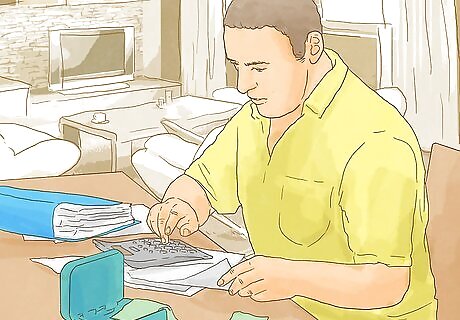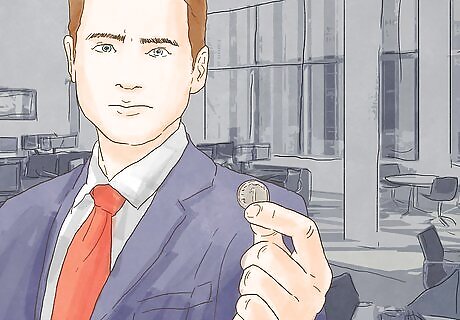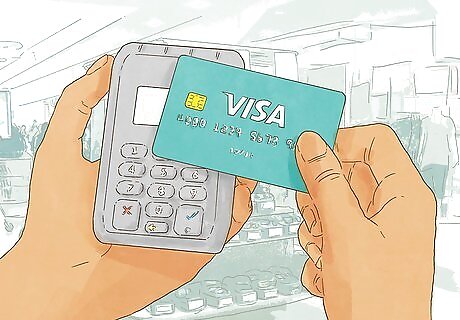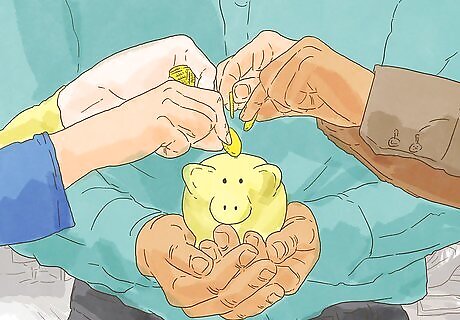
views
X
Research source
[2]
X
Research source
[3]
X
Research source
Rebuilding Your Personal or Business Credit

Monitor your credit report. Filing for bankruptcy is a significant blemish on your credit report, but that doesn't mean you shouldn't worry about anything else. Check your report carefully and act quickly to have any errors corrected. Do everything you can to start rebuilding your personal credit, and you'll start to find it easier to do business with creditors. But try to be patient – rebuilding after bankruptcy can take several years. Any small business you start will have its own credit report, particularly if you requested a new employer identification number (EIN) from the IRS to use with your business. Your business essentially won't have any credit history – it can take several years to establish a business credit report that will actually help you. Because of your business's lack of credit history, any traditional lenders or investors are going to want to look at your finances and credit report as well. This means if you want to start a new business, both are essential.

Create a budget and stick to it. Look at your regular household spending over the course of several months to build a realistic budget that includes all necessary expenses. Estimate your income conservatively to account for potential changes. For example, if your hours at work fluctuate, budget your income based on the least amount you've regularly earned. It's okay not to consider an outlier, such as a week where you missed several days of work due to an illness. When looking at your expenses, list the non-discretionary expenses such as mortgage or rent and utilities first. These are the things you absolutely must pay every month. Don't forget to include a reasonable amount for groceries and personal needs. After you've budgeted your non-discretionary expenses, look at how much you have left. This amount you can allot to various discretionary expenses such as dining out or going to the movies. When you've finished your budget, it may look incredibly strict. If so, try to carve out some money you can use to have a little fun. If you can't be happy living on a budget, you won't follow it.

Establish good spending habits. If you continue treating your finances the same way you did before you filed for bankruptcy, you'll end up right back in the same situation. It can take time and effort to develop responsible habits, but the improvement is worth it. Shopping around for the best deals can help your money go further. Avoid using credit cards for unnecessary items. Pay your bills on time every month. It can help to set up automatic payments, but make sure you can guarantee the money will be in the bank to cover them. If your finances are tight, at least sign up for payment reminders so you don't miss a due date. Plan outings in advance and give yourself a spending limit. For example, if you are going out to a movie, you may want to take $40 in cash and leave any credit or debit cards at home so you aren't tempted to spend more.

Build your savings. If you've just come out of a bankruptcy, you may think the idea of being able to save money is ridiculous. However, no matter how limited your income, it still is possible to put a little away each month. Open a savings account at the bank where you have a checking account. You may be able to save on fees on both accounts if you set up a regular transfer from checking to savings. Look at your budget and see where you have some room for savings. Since you budgeted your income conservatively, you might be able to set up a regular transfer with your bank that way. For example, suppose you budgeted your income at $300 a week. However, many weeks of the year you bring home $400 or more. Make an arrangement with your bank so that when your pay check hits your account, any amount over $300 is automatically transferred to your savings account. This makes it easier to save because you're never touching the money. From your standpoint, you never had the money, so you're not tempted to spend it.

Consider starting with secured loans. If you're unable to get approved for any unsecured credit, you may be able to take out a secured loan by pledging either personal or business assets as collateral. Many banks will offer a secured line of credit if you open up a certificate of deposit account. Keep in mind that you must first have money to put in that deposit account, and you usually must maintain a relatively high minimum balance. Secured credit cards are another option. The credit card company may only give you as much credit as the amount of money you're willing to keep on deposit, but some offer 10 or 20 percent more. When you can deposit more money to secure the card, you can get a higher credit limit. You also may be able to take out loans for your business using business equipment or personal assets such as your home for collateral. Be careful when you do this, however, and make sure you're not over-extending yourself to the point that you risk losing the property you've pledged. With any of these options, make sure the creditor reports to credit bureaus before you take on the loan – otherwise it won't do you any good in terms of rebuilding your credit.
Starting a Small Business Again

Use a different business name. Particularly if you're restarting a business in the same general industry, a new name can avoid confusion with your old business. This can help you work with creditors and customers after your bankruptcy without carrying the baggage of the old business. Going with a different name can be a difficult decision to make, particularly if you had emotional attachment to your original business name. It can help to think of a new name as a fresh start, just like bankruptcy. Before you've settled on your business's name, don't forget to check the business name registry with your state's secretary of state to make sure the name is available. You also want to make sure your new name isn't going to violate anyone else's trademarks. You can run a quick search for your business name on the database located at the U.S. Patent and Trademark Office (USPTO) website. When searching trademarks, watch out for names that are similar to yours as well – especially if they belong to businesses or individuals operating in the same field.

Choose a business structure. You can organize your new business as an LLC or a corporation. You also may choose to run it as a general partnership or a sole proprietorship. However, understand if you go that route it will be next to impossible to separate your new business from your bankruptcy. Keep in mind that businesses cannot file Chapter 7 bankruptcy. However, if you operated an old business as a sole proprietorship, your business is not treated as separate from your personal finances. This time around, you want to make sure you keep your business separate. The easiest way to do this is by forming an LLC. They offer the limited personal liability of a corporation, but with fewer formalities. They also are generally cheaper to create. If you decide to stick with what you know and start another sole proprietorship (or a general partnership, which is treated the same), your bankruptcy is going to have a much greater impact on your ability to do business with creditors. Before you make a final decision, you may want to talk to an experienced business attorney and get their advice on which business structure would be best for you. They also can assist you in getting it set up legally so you can do business in your state.

Get a new employer identification number. To operate your business separately from your personal finances, you must request an employer identification number (EIN) from the IRS. If you had one for your old business, you should get a new one after bankruptcy. If you operated your old business as a sole proprietorship and didn't have any employees, you may have never gotten an EIN before. However, the process is very simple. You can get an EIN online by visiting the IRS's website. Keep in mind that the application service is only available Monday through Friday from 7 a.m. to 10 p.m. Eastern time. On the website, all you have to do is answer a few quick questions about yourself and your business. Once you submit the information, an EIN will be generated for your business automatically. You can use this EIN to set up bank accounts, apply for credit cards and loans, and start establishing a credit history for your business.

Consider adding partners. Especially if you ran your previous business on your own, adding a partner (or two) with a strong credit history can lessen the impact of your bankruptcy when you start looking for financing. If you're thinking about adding a partner, be careful and make sure you look into their business and financial background thoroughly. Given the precarious state of your finances, this is not the time to bring in a partner just because they are a close friend and family member who you like. They may end up doing you more harm than good. Someone with a solid track record in the industry your small business will be a part of is essential. You also want to verify that they have a virtually unblemished credit report – both personally and with any businesses they've previously owned.

Create a conservative budget. If you're trying to rebuild your business's credit after a bankruptcy so you can do business with creditors again, the last thing you want to do is over-extend yourself. Keep any income projections as conservative as possible, and tightly manage your business's revenues. One thing to do when you sit down to work on your budget is look back at your past finances – before you filed for bankruptcy – and how you managed then. The key to developing a responsible budget is to identify where you went wrong before and come up with new practices to replace the old ones that got you into trouble. With time, those new practices will become habit. This process can be beneficial with your personal finances as well as with any small business you're trying to start after going bankrupt. If you're having difficulty with any of the aspects of budget creation, you might want to try searching online for resources that are available for new businesses in your particular industry or field. There also are many resources available on the website of the Small Business Association (SBA). If you're still having trouble, you might want to try talking to an accountant or finance expert – but attempting to do it yourself first can save you some money.

Try to get a business credit card. A business credit card can be used as an important tool to help build your business's credit. Shop around, but realize that you may not be able to get the best interest rate with your credit history. Once you've got your business's bank account set up with your new EIN, the first place you might want to try is the bank where you set up the bank account. Banks often are more willing to give credit cards to customers, but keep in mind you typically will need to have operated that account for at least several months and maintain a healthy balance. Search online for banks and credit card companies that market to new businesses or people with poor or damaged credit. Learn how to use your credit card in a way that will improve your credit score. Try to avoid carrying a balance, instead paying it off every month.
Obtaining Financing

Be up front about your bankruptcy. If you wait to talk about your bankruptcy until lenders or potential investors have found out about it on their own, you lose the opportunity to spin the situation as a positive one that made you more responsible with your finances. Traditional lenders or business investors are going to check your credit, so they will find out about your bankruptcy. If you tell them about it before they check your credit, you can present it as a growing experience and explain how much you've learned about managing your finances since filing for bankruptcy. You also have the opportunity to explain what happened and why you chose to file for bankruptcy. Often people who file for bankruptcy have perfectly legitimate reasons for doing so – reasons that you might even find a lender has sympathy for.

Develop a comprehensive business plan. If you want to start a small business, a well-researched and organized business plan is essential. It sends a message to potential investors that you are serious about your business and have evaluated the risks involved. Particularly in light of your credit history, most traditional lenders will want to see a business plan before they are willing to give you a loan. Your business plan covers details about your business and its organization, your analysis of your industry and the demand for your products or services, as well as projections of your operating expenses and potential profits. If you've never created a business plan and don't know where to start, you can find excellent resources online at places like the SBA website. You also may be able to get ideas by looking at sample business plans created for other existing businesses.

Seek partial investments. After going bankrupt, you may not be able to find an investor who's willing to fund the entire start-up costs for a small business. However, you may have more luck asking for smaller amounts, since the investor has less to lose. If you (or a partner) is able to provide part of your start-up costs, it may not be as difficult to find a lender who is willing to chip in the remaining amount. When you put your own money into your business, however, take care to structure it as a loan and require the business to pay you back. Otherwise, if the business runs into financial trouble, the courts may see your personal investment as a sign that the business really isn't separate from your personal finances and shouldn't be treated as such. This would mean business creditors could potentially go after your personal assets to recover the money you owe them.

Explore alternative financing options. For personal expenses, you may be able to get back on track by using micro-lenders or starting a crowdfunding campaign online. These options also can work in the business context, particularly if you're skilled at selling and marketing your product or services. For example, there are micro-lending websites where you can present your total funding need and get small loans from many investors. These sites can work well if you have a personal shortfall after your bankruptcy, since it can be difficult to obtain a personal loan from a traditional lender. Particularly if you are offering an innovative product or service, starting a crowdfunding campaign can help you get the money you need to get started. Some of these sites require you to have a business motive, while others allow fundraising for any reason. Keep in mind that to be successful with many of these alternative financing options, you typically have to have a sizable and active social network with whom you can share your project. Without being shared far and wide, a crowdfunding campaign has little chance of getting off the ground.

Use caution with loans that require personal guarantees. Many small business loans, such as those offered by the Small Business Association (SBA), require you to make a personal guarantee or to pledge personal assets such as your home. While you don't necessarily have to avoid these options, consider carefully whether you want to risk losing your home or other valuable personal assets if your business doesn't go according to plan. You also should keep in mind that with personally guaranteed loans, you run the risk that if you end up going into default, the creditor may be able to come after other personal assets as well.

















Comments
0 comment